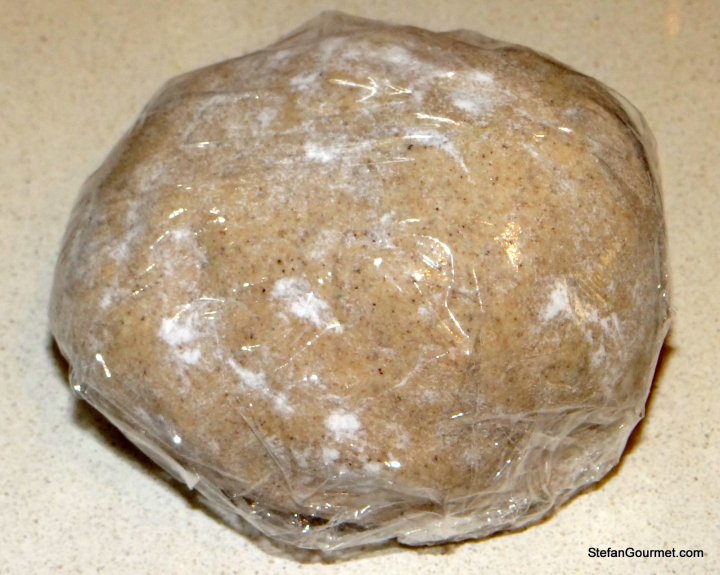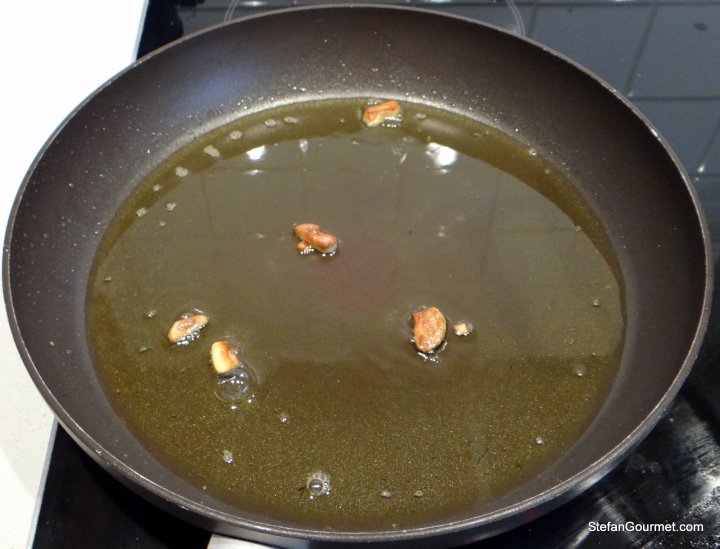Pizzoccheri are a short and flat type of pasta from the Valtellina region in Northern Italy, made from buckwheat and flour. I already posted about preparing store-bought dried pizzoccheri with savoy cabbage. This time I decided to make the pizzoccheri myself, and use chard rather than cabbage. I already liked pizzoccheri the previous time I made them, but the fresh pasta and the chard make it even better.
Did you know that buckwheat, despite its name, is not a wheat? It is also interesting that the word buckwheat has been derived from the Dutch word “boekweit”. In Italian it sounds more fancy though: grano saraceno. In any case, in homemade pizzoccheri you can taste the buckwheat better than in store-bought ones, and they are surprisingly easy to make as they do not need to be rolled out as thinly as for other types of fresh pasta. So even though I did use my pasta roller out of habit, you could easily and quickly make them with a rolling pin. The fresh pizzoccheri also have a nicer texture than the dried ones.

Pizzoccheri alla Valtellinese is a substantial dish, so unlike other pasta dishes that are supposed to serve as part of a menu, pizzoccheri are typically served as piatto unico, a full meal consisting of just this done dish. I used the recipe from GialloZafferano, but increased the amount of chard. Pizzoccheri are traditionally served with the cheese from the valley where the dish originated: valtellina casera. This cheese is important to get the authentic taste, but if you can’t find it then fontina can be used as a substitute. Pizzoccheri are traditionally served family style in a large dish, but I prefer to toss them with the cheese and serve on individual plates.
Ingredients
200 grams (1 1/4 cups) buckwheat flour
50 grams (1/4 cup) 00 flour or all-purpose flour
125 ml (1/2 cup) water
pinch of salt
50 grams (3 1/2 Tbsp) butter
75 grams (3 oz) freshly grated grana padano or parmigiano reggiano
125 grams (5 oz) freshly grated Valtellina Casera cheese (substitute with Fontina)
175 grams potatoes (about 1 large or 2 medium potatoes)
200 grams (7 oz) chard, leaves only (or savoy cabbage)
1 clove garlic
freshly ground black pepper
Preparation

Put the buckwheat flour, regular flour, and salt in the bowl of a stand mixer fitted with the paddle attachment.

Turn on the stand mixer at medium speed and slowly add the water.

Mix until the dough has come together.

Remove the paddle attachment and insert the dough hook.

Knead for 5 minutes until the dough is smooth and pliable.

Cover with plastic wrap and refrigerate for half an hour.

Meanwhile, grate the two cheeses, clean and roughly chop the chard, and peel and dice the potatoes (1 cm or 1/2 inch dice).

You can roll out the dough with a rolling pin or with a pasta roller. To do it with a pasta roller, take half of the dough, flatten it with your hands, and sprinkle with flour.

Run it through the pasta machine at the widest setting. The dough should be 2-3 mm thick (1/12 – 1/8 inch). In my case, this meant that running it through the pasta machine once at the widest setting was enough.

Put the rolled out dough on a floured work surface.

Cut it into pieces of about 7-8 cm (3 inches) long and about 1-1.5 cm (1/2 inch) wide.

You can do this more quickly by stacking several layers of dough, which will work fine as long as everything is sprinkled with flour.

The pizzoccheri are now ready to be cooked.

Bring a large pot of water to a boil and add salt and potatoes.

Also add the chard and boil for 5 minutes.

Add the pizzoccheri and boil for another 10 minutes.

Meanwhile, melt the butter and allow the garlic to turn brown in the hot butter. Discard the garlic before it burns.

Drain the pizzoccheri and vegetables in a colander, reserving some of the cooking water.

Add to the garlic-infused butter with the cheese and freshly ground black pepper.

Toss to mix over low heat, adding a few tablespoons of the cooking water if needed.




Very nice. I have some kale in my fridge that needs a recipe. I hadn’t thought of pasta (and I don’t have buckwheat), but maybe a nice thick pasta with kale and some bacon would work nicely.
LikeLike
You could also add walnuts and blue cheese to that.
LikeLike
You had me at buckwheat! Beautiful recipe!
LikeLike
Thanks, Mimi. Unfortunately it’s still cold enough around here for such wintry food.
LikeLike
I am in the desert, just took a two hour hike and it’s getting really hot. Still, you made me crave a winter dish I only have in the Dolomites….and no chance of finding it here (don’t even suggest I make them here, in a kitchen that is not mine)
LikeLike
Puoi farli quando sei tornata a casa tua 🙂 Saluti dalla Sicilia 🙂
LikeLike
Interesting, no eggs? I’m going to try making this pasta! I love pasta with greens & potatoes, such a great flavor and texture combination.
LikeLike
Great! Thought you might like this 🙂 This type of fresh pasta is made without eggs. I believe eggless used to be the norm, when eggs were still somewhat of a luxury. (Now the nutricional value for money of eggs is astounding.) There are other traditional types of pasta with water, such as orecchiette. I’m going to post about another eggless pasta with vegetables and potatoes in a few weeks: trenette col pesto.
LikeLike
You know I’ll be staying tuned! 🙂
LikeLike
A blogging friend introduced me to this dish. Until then, I’d no idea that there was a dish that combine buckwheat noodles, potatoes, and cabbage. It sure was tasty, though, and I’m sure using chard instead of cabbage would be very good. Will have to give this a try next Fall because we are surely done with cold weather now. Surely we are. Please let it be so! 🙂
LikeLike
The weather seems to be all messed up this year. Even here in Sicily it’s colder than it’s supposed to be.
LikeLike
🙂 It’s very good comfort food. I’m in Sicily and even there it’s not quite warm yet…
LikeLike
This looks very good. I am looking for a nice Pizzoccheri recipe, but it has to be totally gluten-free… Do you know whether this would also work with gluten-free flour instead of the all purpose? I appreciate any insights. Thanks, Meike!
LikeLike
The reason for including regular flour instead of only buckwheat, is the binding properties of the gluten in regular flour. To make up for the binding properties of the gluten in regular flour, my advice when using gluten-free flour is to replace some of the water with a beaten egg. Let me know how it turns out.
LikeLike